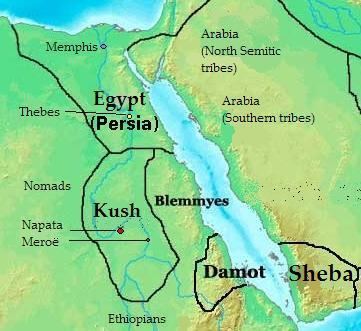Government Monarchy Disestablished c. 400 BC | Established c. 980 BC Capital Yeha | |
 | ||
Dʿmt (South Arabian alphabet: ; Unvocalized Ge'ez: ደዐመተ, DʿMT theoretically vocalized as ዳዓማት Daʿamat or ዳዕማት Daʿəmat) was a kingdom located in Eritrea and northern Ethiopia that existed during the 10th to 5th centuries BC. Few inscriptions by or about this kingdom survive and very little archaeological work has taken place. As a result, it is not known whether Dʿmt ended as a civilization before Aksum's early stages, evolved into the Aksumite state, or was one of the smaller states united in the Aksumite kingdom possibly around the beginning of the 1st century.
Contents
History
Given the presence of a large temple complex and fertile surroundings, the capital of Dʿmt may have been present day Yeha, in Tigray, Ethiopia.
The kingdom developed irrigation schemes, used plows, grew millet, and made iron tools and weapons.
Some modern historians including Stuart Munro-Hay, Rodolfo Fattovich, Ayele Bekerie, Cain Felder, and Ephraim Isaac consider this civilization to be indigenous, although Sabaean-influenced due to the latter's dominance of the Red Sea, while others like Joseph Michels, Henri de Contenson, Tekle-Tsadik Mekouria, and Stanley Burstein have viewed Dʿmt as the result of a mixture of Sabaeans and indigenous peoples. The most recent research, however, shows that Ge'ez, the ancient Semitic language spoken in Eritrea and northern Ethiopia in ancient times, is not derived from Sabaean. There is evidence of a Semitic-speaking presence in Eritrea and northern Ethiopia at least as early as 2000 BC. It is now believed that Sabaean influence was minor, limited to a few localities, and disappeared after a few decades or a century, perhaps representing a trading or military colony in some sort of symbiosis or military alliance with the civilization of Dʿmt or some other proto-Aksumite state.
After the fall of Dʿmt in the 5th century BC, the plateau came to be dominated by smaller unknown successor kingdoms. This lasted until the rise of one of these polities during the first century BC, the Aksumite Kingdom. The ancestor of medieval and modern Eritrea and Ethiopia, Aksum was able to reunite the area.
Name
Due to the similarity of the name of Dʿmt and Damot when transcribed into Latin characters, these two kingdoms are often confused or conflated with one another, but there is no evidence of any relationship to Damot, a kingdom far to the south. Daʿamat دعمت in Arabic translates as 'supported' or 'columned', and may refer to the columns and obelisks (or Hawulti) of Matara or Qohaito.
Known rulers
The following is a list of four known rulers of Dʿmt, in chronological order:
